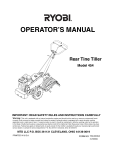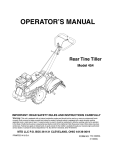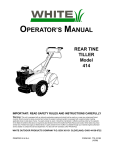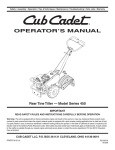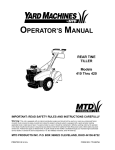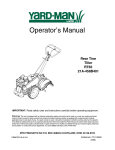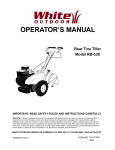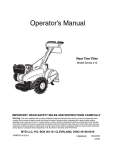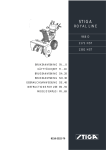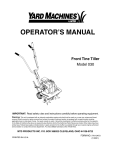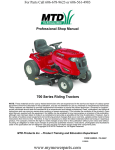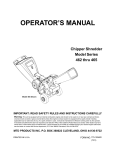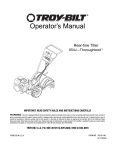Download White RB650 User's Manual
Transcript
REAR TINE TILLER MODEL RB650 21A-458B190 IMPORTANT: READ SAFETY RULES AND INSTRUCTIONS CAREFULLY Warning: This unit is equipped with an internal combustion engine and should not be used on or near any unimproved forestcovered, brush-covered or grass-covered land unless the engine’s exhaust system is equipped with a spark arrester meeting applicable local or state laws (if any). If a spark arrester is used, it should be maintained in effective working order by the operator. In the State of California the above is required by law (Section 4442 of the California Public Resources Code). Other states may have similar laws. Federal laws apply on federal lands. A spark arrester for the muffler is available through your nearest engine authorized service dealer or contact the service department, P.O. Box 361131 Cleveland, Ohio 44136-9722. WHITE OUTDOOR PRODUCTS COMPANY P.O. BOX 361131 CLEVELAND, OHIO 44136-9722 PRINTED IN U.S.A. FORM NO.770-10193 (12/98) SECTION 1: FINDING YOUR MODEL NUMBER This Operator’s Manual is an important part of your new tiller. It will help you assemble, prepare and maintain your tiller. Please read and understand what it says. Before you start to prepare your tiller for its first use, please locate the model plate and copy the information from it in this Operator’s Manual. The information on the model plate is very important if you need help from your dealer or the customer support department. • Every tiller has a model plate. You can locate it by standing in the operating position behind the unit and looking down at the center of the rear tine cover. • The model plate will look like Figure 1. This is where your model number will be. XXX-X-XXX-X-XXX XXXXXXXXXXX This is where your serial number will be. WHITE OUTDOOR PRODUCTS COMPANY P.O. BOX 361131 CLEVELAND, OHIO 44136 Copy the model number here: Copy the serial number here: Figure 1 SECTION 2: CALLING WARRANTY SERVICE If you are having difficulty assembling this product or if you have any question regarding the controls, operation or maintenance of this unit, please call the Customer Dealer Referral Line. You can reach them by calling: 1-800-949-4483 Before calling your local dealer, make sure that you have your model and serial numbers ready. By having the model and serial numbers ready, you help your local dealer give you faster service. To find your unit’s model and serial number, see SECTION 1: FINDING YOUR MODEL NUMBER. 2 SECTION 3: IMPORTANT SAFE OPERATION PRACTICES WARNING: THIS SYMBOL POINTS OUT IMPORTANT SAFETY INSTRUCTIONS WHICH, IF NOT FOLLOWED, COULD ENDANGER THE PERSONAL SAFETY AND/OR PROPERTY OF YOURSELF AND OTHERS. READ AND FOLLOW ALL INSTRUCTIONS IN THIS MANUAL BEFORE ATTEMPTING TO OPERATE YOUR TILLER. FAILURE TO COMPLY WITH THESE INSTRUCTIONS MAY RESULT IN PERSONAL INJURY. WHEN YOU SEE THIS SYMBOL— HEED ITS WARNING. WARNING: The Engine Exhaust from this product contains chemicals known to the State of California to cause cancer, birth defects or other reproductive harm. DANGER: Your tiller was built to be operated according to the rules for safe operation in this manual. As with any type of power equipment, carelessness or error on the part of the operator can result in serious injury. This tiller is capable of amputating hands and feet. Failure to observe the following safety instructions could result in serious injury or death. 1. GENERAL OPERATION • Do not place feet or hands on or near the tines when starting the engine or while the engine is running. • Read this operator’s manual carefully in its entirety before attempting to assemble this machine. Read, understand, and follow all instructions on the machine and in the manual(s) before operation. Be completely familiar with the controls and the proper use of the machine before operating it. Keep this manual in a safe place for future and regular reference and for ordering replacement parts. • Never attempt to make depth bar, tine width, cable, handle, or wheel adjustments while the engine is running. • Do not leave the tiller unattended with the engine running. • Your tiller is a powerful tool, not a plaything. Therefore, exercise extreme caution at all times. Your unit has been designed to perform one job: to till soil. Do not use it for any other purpose. • Before attempting to remove rocks, bricks and other objects from tines, stop the engine and be sure the tines have stopped completely. Disconnect the spark plug wire and move it away from the spark plug. • Never allow children under age 14 to operate the unit. Children 14 years and older should only operate the unit under close parental supervision. Only responsible individuals who are familiar with these rules of safe operation should be allowed to use your unit. • If your machine should start making an unusual noise or vibration, immediately stop the engine and allow the machine to come to a complete stop. Disconnect the spark plug wire and move it away from the spark plug. Take the following steps: • Do not operate tiller while under the influence of alcohol or drugs. • Inspect for damage. • Repair or replace any damaged parts. • Keep the area of operation clear of all persons, particularly small children and pets. Stop the engine when they are in the vicinity of your tiller. • Check for any loose parts and tighten to assure continued safe operation. • Wear sturdy, rough-soled work shoes and close fitting slacks and shirt. Shirt and slacks that cover the arms and legs and steel-toed shoes are recommended. Do not wear loose fitting clothes or jewelry and secure hair so it is above shoulder length. They can be caught in moving parts. Never operate a unit in bare feet, sandals or sneakers. • Muffler and engine become hot and can cause a burn. Do not touch. • Keep all shields, guards and safety devices in place and operating properly. • Use caution when tilling near fences, buildings and underground utilities. Rotating tines can cause damage or injury. • Operate tiller only in daylight or good artificial light. • Do not operate engine if air cleaner or cover over carburetor air intake is removed, except for adjustment. Removal of such parts could create a fire hazard. • Do not start tiller unless the shift lever (if provided) is in the neutral (N) position. • Do not allow anyone to stand or walk in front of tiller when starting or running engine. 3 • Only use accessories approved for this machine by the manufacturer. Read, understand, and follow all instructions provided with the approved accessory. • Extinguish all cigarettes, cigars, pipes and other sources of ignition. • Never refuel unit indoors because flammable vapors will accumulate in the area. • If situations occur which are not covered by this manual, use care and good judgment. Contact your dealer for assistance. • Never store the machine or fuel container inside where there is an open flame or spark such as a gas hot water heater, space heater, clothes dryer or furnace. 2. CHILDREN • Tragic accidents can occur if the operator is not alert to the presence of small children. Children are often attracted to the tilling activity. Never assume that children will remain where you last saw them. • Never run your machine in an enclosed area as the exhaust from the engine contains carbon monoxide, which is a odorless, tasteless and deadly poisonous gas. • Keep children out of the work area and under the watchful eye of a responsible adult other than the operator. • To reduce fire hazard, keep engine and muffler free of leaves, grass, and other debris build-up. Clean up fuel and oil spillage. Allow unit to cool at least 5 minutes before storing. • Be alert and turn the unit off if a child enters the area. • Before cleaning, repairing, or inspecting, make certain the tines and all moving parts have stopped. Disconnect the spark plug wire and keep wire away from spark plug to prevent accidental starting. Do not use flammable solutions to clean air filter. • Never allow children under the age of 14 to operate the tiller. 3. SERVICE • Use extreme care in handling gasoline and other fuels. They are extremely flammable and the vapors are explosive. • Keep all nuts, bolts, and screws tight to be sure the equipment is in safe working condition. • Never tamper with safety devices. Check their proper operation regularly. • Store fuel and oil in approved containers, away from heat and open flame, and out of the reach of children. Check and add fuel before starting the engine. Never remove gas cap or add fuel while the engine is running. Allow engine to cool at least two minutes before refueling. • Do not alter or tamper with the engine’s governor setting. The governor controls the maximum safe operating speed of the engine. Overspeeding the engine is dangerous and will cause damage to the engine and to other moving parts of the machine. • Replace gasoline cap securely and wipe off any spilled gasoline before starting the engine as it may cause a fire or explosion. WARNING — YOUR RESPONSIBILITY: Restrict the use of this power machine to persons who read, understand and follow the warnings and instructions in this manual and on the machine. Figure 2 Safety labels found on your unit 4 SECTION 4: LOOSE PARTS Handle Assembly Control Rod NOTE: Cable tie not shown. 5 Depth Stake Assembly SECTION 5: ASSEMBLY INSTRUCTIONS IMPORTANT: This unit is shipped WITHOUT ATTACHING DEPTH STAKE ASSEMBLY GASOLINE or OIL. After assembly, see separate engine manual for proper fuel and engine oil recommendations. 1. Tip the tiller forward so it rests on front counterweight. 2. Raise the tine shield hinge flap assembly. Remove "T" knob, flat washer and hex bolt from depth stake. Insert the depth stake assembly in front of spacer (under the tine shield) and up through the tine shield assembly as shown in Figure 3. NOTE: Left and right is determined from the operator’s position, standing behind the tiller. TOOLS REQUIRED FOR ASSEMBLY Adjustable Wrenches Pair of Pliers 3. Insert clevis pin through the tine shield and the second hole from top of the depth stake. Secure with hairpin clip. TO REMOVE UNIT FROM CARTON 4. Insert hex bolt into the top hole of the depth stake assembly. Place flat washer on hex bolt and thread “T” knob onto the hex bolt. See Figure 3. Tighten securely. 1. Remove staples, break glue on top flaps, or cut tape at carton end and peel along top flap to open carton. 2. Remove loose parts included with unit (i.e., operator’s manual, etc.). 5. Tip the tiller back down so it rests on the depth stake (transport position). 3. Cut along dotted lines and lay carton down flat. ATTACHING THE HANDLE ASSEMBLY 4. Remove packing material. 5. Roll or slide unit out of carton. Check carton thoroughly for loose parts. 6. Extend control cable and lay on the floor. Be careful not to bend or kink control cable. T-Handle Washer Remove Handle Ass’y Hex Bolt Depth Stake Handle Bracket T-Knob Hex Bolt Washer Clevis Pin Hairpin Clip Figure 4 1. Remove top two bolts and flange lock nuts from handle mounting brackets as shown in Figure 4. Do not remove the bottom bolt and nut. 2. Place handle assembly in position between the handle mounting brackets. See Figure 4. Depth Stake 3. Line up holes in handle with holes in handle mounting brackets. Secure with hardware removed in step 1. Figure 3 6 3. Pull the cable upwards to obtain slack, push the "Z" end into the bail. You will need to attach "Z" fitting from the inside to the outside.See Figure 6. 4. With the clutch control bail released, adjust the bottom nut at the cable bracket three turns up from end of threads. Tighten the upper nut against the bracket. Carefully squeeze the clutch control bail against the handle. The control wire should now be straight. Hex Nut NOTE: Do not overtighten control wire. Too much tension may cause it to break. Slot in Cable Bracket Washer WARNING: Be certain to check the clutch cable adjustment as instructed on page 7 of your owner’s guide before operating the tiller. Hex Nut Secure drive cable to handle using cable tie. Refer to Figure 8. Cut off excess end of cable tie. Figure 5 ATTACHING THE CLUTCH CABLE ATTACHING THE CONTROL ROD Attach the clutch cable to the handle as follows (be careful not to kink the cable). 1. Remove hairpin clips from control rod, (rubber washers to remain on control rod). 1. Route the clutch cable to the left side of the tiller, and underneath the handle. Remove one hex nut and lock washer from the end of the casing on the clutch cable. Thread the other nut all the way onto the threaded casing, as far as it will go. 2. Insert one end of the control rod through the indicator bracket on the shift cover and secure with hairpin clip that was removed in step 1. See Figure 7. 3. Insert the remaining end of the control rod through the hole in the gear selector handle and secure with hairpin clip. See Figure 8. 2. Slip the wire through the slot on the cable bracket on the handle. Push the end of the casing up through the cable bracket. Slide the lock washer on the casing and rethread the hex nut on the end of the cable casing, four turns. Do not tighten at this time. See Figure 5. . Control Rod Rubber Washer Idler Pulley Rod "Z" Fitting Indicator Bracket Hairpin Clip Figure 7 CHECKING THE CLUTCH ADJUSTMENT IMPORTANT: Service the engine with oil and gasoline before checking this adjustment. Refer to the separate engine manual packed with your tiller for proper fuel and engine oil recommendations. Clutch Control Bail Figure 6 7 Recheck both necessary. Position the tiller so the front counterweight is against a solid object, such as a wall. With the gear selection lever in NEUTRAL, start the engine. Refer to the separate engine manual. Standing on the right side of the tiller, examine the belt (inside the belt cover). It should not be turning. adjustments, and readjust as NOTE: A secondary cable adjustment is available if you reach the point that additional adjustment is needed. Remove the belt cover and move the hex nuts at the other end of the cable towards the end of the casing. Then readjust the hex nuts at the handle. NOTE: Do not put fingers under the belt cover. If the belt turns with the unit in neutral, adjust by moving the hex nut below the cable bracket down two full turns. See Figure 5. Tighten the upper hex nut against the bracket. Now move the shift lever to FORWARD (Wheels Forward) position. Carefully engage the clutch by lifting the clutch control bail against the handle. The wheels should spin. If the wheels do not spin with the unit in forward, adjust by moving the hex nut which is above the cable bracket up two full turns. Tighten the bottom hex nut against the bracket. TIRE PRESSURE The tires on your unit may be over-inflated for shipping purposes. Reduce the tire pressure before operating the unit. Recommended operating tire pressure is approximately 20 p.s.i. (check sidewall of tire for tire manufacturer’s recommended pressure). WARNING: Maximum tire pressure under any circumstances is 30 p.s.i. Equal tire pressure should be maintained on both tires. SECTION 6: CONTROLS GEAR SELECTION HANDLE The gear selection handle is located in the center of the handle on the tiller. It is used to select NEUTRAL, REVERSE, or one of the FORWARD modes (see below). Pull or push the handle so that the indicator on top of shift cover points to the operating mode desired. See Figure 8. NEUTRAL—Transmission is in neutral. REVERSE—Reverse wheel drive. FORWARD Modes: Wheels Forward— Forward wheel drive only. Tines Reverse— Forward wheel drive and reverse tine drive. Tines Forward— Forward wheel and tine drive. Gear Selection Handle Control Rod Clutch Control Control Cable Bail Height Adjustment Crank WARNING: Make certain unit is in Cable Tie NEUTRAL when starting the engine. Figure 8 NOTE: If difficulty is encountered in moving the gear selection handle, move the tiller forward or backward slightly to allow the gears to synchronize. THROTTLE CONTROL The throttle control lever is located on the engine. It controls the engine speed and stops the engine. See Engine manual for further information. CLUTCH CONTROL BAIL The clutch control bail is located below the handle. See Figure 8. Lifting the clutch control bail against the handle engages the wheel and tine drive mechanisms. CHOKE LEVER The choke lever is located to the left of the throttle. It is used to enrich the fuel mixture in the carburetor when starting a cold engine. See Engine manual for further information. NOTE: Never engage clutch lever while shifting. 8 DEPTH STAKE HANDLE ADJUSTMENT (See Figure 8) The depth bar controls the tilling depth. Refer to SECTION 8: HOW TO USE YOUR TILLER on page 9. The handle may be adjusted to be raised or lowered in line with the tiller. To adjust the handle position loosen the handle height adjustment crank a few turns. Pivot handle up or down to desired position. Tighten crank. SECTION 7: OPERATION NOTE: Engine is shipped without oil. 3. Stand at side of tiller. Grasp the starter handle and pull out slowly, until it pulls slightly harder. Let rope rewind slowly. WARNING: Before operating the tiller, be certain to read SECTION 8: HOW TO USE YOUR TILLER on page 9. Use the reverse tine drive when tilling virgin ground, sod or hard soil. Use the forward tine drive when cultivating or tilling soft ground. 4. Pull starter handle rapidly. Do not allow handle to snap back. Allow it to rewind slowly while keeping a firm hold on the starter handle. 5. Repeat steps 3 and 4 until engine starts. 6. As engine warms up and begins to operate evenly, move choke lever gradually to RUN position. If engine falters, return to choke position, then slowly move to RUN position. BEFORE STARTING 1. Service engine with oil as instructed in the separate engine manual packed with your unit. 7. Refer to engine manual for additional engine information. 2. Fill fuel tank with clean, fresh, lead-free, low-lead or regular grade leaded gasoline. NOTE: After starting engine and prior to using the tiller, be certain to check the clutch adjustment as described in “Checking the Clutch Adjustment” section of Assembly Instructions. TO START ENGINE TO STOP ENGINE WARNING: Be Sure No One Is Standing In Front Of The Tiller While The Engine Is Running Or Being Started. 1. Move throttle control to the STOP position. 2. Disconnect spark plug wire and ground to prevent accidentally starting while equipment is unattended. 1. Place the throttle control lever in the FAST (rabbit) position. NOTE: After the first ten hours of operation, recheck the clutch adjustment. Refer to “Checking the Clutch Adjustment” section of the Assembly Instructions. 2. Move choke lever to CHOKE position. NOTE: A warm engine may not require choking. SECTION 8: HOW TO USE YOUR TILLER WARNING: When operating the tiller for the first time, use the depth stake setting that gives 1 inch of tilling depth (second hole from the top). See Figure 9. 2. When breaking up sod and for shallow cultivation, use the setting which gives 1" of tilling depth (second hole from the top). Place the side shields in their lowest position. For further depth, raise the depth stake and side shields and make one or two more passes over the area. Tilling depth is controlled by the depth stake which can be adjusted to five different settings. See Figure 9. Adjust the side shields as shown in Figure 10, as you adjust the depth stake. Be certain spark plug wire is disconnected and grounded against the engine. 3. When tilling loose soil, depth stake may be raised to its highest position (use bottom adjustment hole) to give the deepest tilling depth. Raise the side shields to their highest position. 1. When using the tiller for the first time, use the second adjustment hole from the top (1" of tilling depth). See Figure 9. 9 TO OPERATE THE TILLER: 1. Select the depth stake setting. 2. Start engine as instructed on page 9. Transport Position Use This Position First Time 3. Move gear selection handle to one of the forward modes or reverse. Use the reverse tine drive when tilling virgin ground, sod or hard soil. Use the forward tine drive when cultivating or tilling soft ground. Clevis Pin IMPORTANT: When using the forward tine drive, lower the depth stake (use a shallower tilling depth) to make certain the tines do not run across the ground. Hairpin Clip WARNING: Do not move the gear selection handle with the wheels or tines engaged. Make certain the unit is stopped completely before changing the gear selection. Figure 9 4. To transport tiller, lower the depth stake (use top adjustment hole). 5. To adjust the depth stake, remove the clevis pin and hairpin clip. See Figure 9. Move the depth stake to the desired setting. 4. Squeeze the clutch control bail against the handle to engage the wheels and tines. 6. To adjust the side shields, remove the wing nuts. See Figure 10. Place side shield in position desired. Replace wing nuts and tighten securely. Use This Hole for Lowest (Shallowest) Position NOTE: Make certain the gear selection indicator is correctly positioned before engaging the clutch handle. If it is between gears, the engine will stall. To transport tiller, do not engage the tines. Select the wheel drive only. Side Shields WARNING: Do not push down on the handles so that the wheels are lifted off the ground while using the reverse tine drive, or the tiller could move backward and cause personal injury. For best results, it is recommended the garden be tilled twice (lengthwise, then widthwise) to pulverize the soil. Use This Hole for Highest (Deepest) Position Figure 10 SECTION 9: ADJUSTMENTS HANDLE ADJUSTMENT BELT TENSION ADJUSTMENT The handle height may be adjusted. Refer to the Control section for details of handle adjustment. Periodic adjustment of the belt tension may be required due to normal stretch and wear on the belt. Adjustment is needed if the tines or wheels seem to hesitate while turning, but the engine maintains the same speed. 10 5. Replace the wave washer and hairpin clip. To adjust the tension on the belt, refer to clutch adjustment information in “Checking the Clutch Adjustment” section of the Assembly Instructions. After belt tension has been adjusted, if the belt is excessively stretched, you may need to adjust the idler pulley rod. This can easily be checked. With the engine off and the clutch control bail disengaged, shift the gear selection handle to each forward mode. If the indicator bracket touches the idler pulley rod, (with the clutch control bail disengaged), then an adjustment is necessary. 6. Check clearance of the idler pulley rod to the indicator bracket by shifting to each forward mode, as before. CARBURETOR ADJUSTMENT WARNING: If any adjustments are made to the engine while the engine is running, (e.g. carburetor), disengage all clutches and tines. Keep clear of all moving parts. Be careful of heated surfaces and muffler. 1. Disconnect and ground out spark plug wire against the engine. 2. Remove the belt cover as described in the belt replacement section on page 12. Never make unnecessary adjustments. The factory settings are correct for most applications. If adjustments are needed, refer to the separate engine manual packed with your tiller. 3. Remove the hairpin clip and flat washer from the idler pulley rod. See Figure 12. 4. Move the idler pulley rod to the lower hole in the idler bracket. See Figure 12. SECTION 10: LUBRICATION Clutch Bail—Lubricate the pivot point on the clutch bail and the cable at least once a season with light oil. The control must operate freely in both directions. Pivot Points—Lubricate all pivot points and linkages at least once a season with light oil. Tine Shaft—Remove tines at least once a season and lubricate with oil. Wheel Axle—Remove the wheel assemblies at least once a season and lubricate with oil. Transmission—The transmission is pre-lubricated and sealed at the factory. It requires no checking unless the transmission is disassembled. To fill with grease, lay the right half of the transmission on its side. Add 30 ounces of Benalene 920 grease. Apply a bead of RTV or silicone sealant to the right half of the transmission, all the way around the gear compartment. Assemble the left half to it. This grease can be obtained at your nearest authorized dealer. Order part number 737-0300. SECTION 11: MAINTENANCE WARNING: Disconnect the spark plug replacement is recommended at the start of each tiller season; check engine manual for correct plug type and gap specification. Clean the engine regularly with a cloth or brush. Keep the cooling system (blower housing area) clean to permit proper air circulation which is essential to engine performance and life. Be certain to remove all dirt and combustible debris from muffler area. wire and ground it against the engine before performing any repairs or maintenance. ENGINE Refer to the separate engine manual for engine maintenance instructions. Maintain engine oil as instructed in the separate engine manual packed with your unit. Read and follow instructions carefully. Service air cleaner every ten hours under normal conditions. Clean every hour under extremely dusty conditions. Poor engine performance and flooding usually indicates that the air cleaner should be serviced. To service the air cleaner, refer to the separate engine manual packed with your unit. CLEANING THE TINE AREA Clean the underside of the tine shield after each use. The dirt washes off the tines easier if washed off immediately instead of after it dries. IMPORTANT: Never run your engine without air cleaner completely assembled. The spark plug should be cleaned and the gap reset every 25 hours of engine operation. Spark plug 11 BELT REPLACEMENT NOTE: Upon reassembly, make certain the belt is routed over the idler pulley and inside of belt keepers by engine pulley. See Figure 12. CAUTION: Do not use an off-the-shelf belt. Idler Pulley Rod Your tiller has been engineered with a belt made of special material (Kevlar Tensile) for longer life and better performance. It should not be replaced with an off-the-shelf belt. If belt replacement is required, order belt or belts by part number from your nearest authorized dealer. Part No. 754-0434—‘‘V’’ Belt 1. Disconnect and ground the spark plug wire against the engine. Engine Pulley 2. Remove the belt cover from the left side of the tiller as follows: See Figure 11.Remove two torx screws from the top of belt cover. Idler Brkt. Figure 12 3. Remove the hex cap nut and flat washer from the side of the belt cover. Remove the hex screw at the bottom of the front of the cover. TIRES Recommended operating tire pressure is approximately 20 p.s.i. (check sidewall of tire for tire manufacturer’s recommended pressure). Maximum tire pressure under any circumstances is 30 p.s.i. Equal tire pressure should be maintained on both tires. When installing a tire to the rim, be certain rim is clean and free of rust. Lubricate both the tire and rim generously. Never inflate to over 30 p.s.i. to seat beads. 4. Remove the belt keeper bracket located behind the engine pulley by removing two hex bolts and lock washers. See Figure 12. 5. Remove belt. Reassemble new belt, following instructions in reverse order. Torx Screws Belt Keeper Brkt. WARNING: Excessive pressure (over 30 p.s.i.) when seating beads may cause tire/rim assembly to burst with force sufficient to cause serious injury. Belt Cover Hex Cap Nut Self Tap Screw Figure 11 12 SECTION 12: OFF-SEASON STORAGE 3. Wipe tines with oiled rag to prevent rust. If the tiller will not be used for a period longer than 30 days, the following steps should be taken to prepare the tiller for storage. 4. Store tiller in a clean, dry area. Do not store next to corrosive materials, such as fertilizer. 1. Clean the exterior of engine and the entire tiller thoroughly. Lubricate the tiller as described in the lubrication instructions. NOTE: When storing any type of power equipment in an unventilated or metal storage shed, care should be taken to rustproof the equipment. Using a light oil or silicone, coat the equipment, especially any springs, bearings and cables. 2. Refer to the engine manual for correct engine storage instructions. SECTION 13: TROUBLE SHOOTING GUIDE Trouble Possible Cause(s) Corrective Action Engine fails to start Fuel tank empty, or stale fuel. Fill tank with clean, fresh gasoline. Fuel will not last over thirty days unless a fuel stabilizer is used. Move throttle lever to start position. Engine runs erratic Engine overheats Tines do not engage Tines skip over ground Wheels do not engage Throttle control lever not in correct starting position (if so equipped). Blocked fuel line. Dirty aircleaner. Choke not in ON position. Spark plug wire disconnected. Faulty spark plug. Engine flooded. Unit running on CHOKE. Spark plug wire loose. Blocked fuel line or stale fuel. Vent in gas cap plugged. Water or dirt in fuel system. Dirty air cleaner. Carburetor out of adjustment. Engine oil level low. Dirty air cleaner. Air flow restricted. Carburetor not adjusted properly. Foreign object lodged in tines. Tine clevis pin(s) missing. Pulley and idler not in correct adjustment. Not shifting properly. Control cable not adjusted properly. Belt worn and/or stretched. Improper rotation. Clevis pin missing. Tiller is not being shifted properly. Control cable not adjusted properly. Belt worn and/or stretched. Clean fuel line. Refer to the engine manual packed with your unit. Move switch to ON position. Connect wire to spark plug. Clean, adjust gap or replace. Refer to the engine manual packed with your unit. Move choke lever to OFF position. Connect and tighten spark plug wire. Clean fuel line; fill tank with clean, fresh gasoline. Fuel will not last over thirty days unless a fuel stabilizer is used. Clear vent. Drain fuel tank. Refill with fresh fuel. Refer to the engine manual packed with your unit. Refer to the engine manual packed with your unit. Fill crankcase with proper oil. Refer to the engine manual packed with your unit. Refer to the engine manual packed with your unit. Adjust carburetor as instructed in separate engine manual. Dislodge foreign object. Replace tine clevis pin(s). Take unit to authorized service dealer. Refer to Controls section of operator’s manual for proper shifting procedures. Adjust control cable (see assembly instructions). Replace belt. Forward rotation should only be used on soil that has already been tilled, not on virgin soil. Replace clevis pin. Refer to Controls section of operator’s manual for proper shifting procedures. Adjust control cable (see assembly instructions). Replace belt. Note: For repairs beyond the minor adjustments above, contact your local authorized service dealer. 13 Model 458 14 Model 458 REF. NO. 1 2 3 4 5 6 7 8 9 10 11 12 13 14 15 16 17 18 19 20 21 22 23 24 25 26 27 PART NO. 611-0020 611-0021 611-0128 611-0129 617-0058 617-0059 617-0060 617-0061 617-0062 686-0108 710-0376 710-0599 710-0604 710-3008 711-1349 712-0378 712-3004A 713-0367 713-0484 716-0865 717-0853 717-1582 717-1583 717-1584 717-1585 717-1587 717-1594 REF. NO. DESCRIPTION 28 29 31 32 33 34 35 36 37 40 41 42 43 44 45 46 47 48 49 50 51 52 53 - Wheel Shaft Ass’y: 33T Tine Shaft Ass’y: 18T Jack Shaft Ass’y Input Shaft Ass’y Rev. Idler Gear Ass’y: 30T Ftine Idler Gear Ass’y: 30T Tine Input Sprocket Ass’y: 9T Wheel Input Sprocket Ass’y: 10T Gear Ass’y: 11T R.H. Housing Ass’y Hex Bolt 5/16-18 x 1" Lg. Hex S-Tap Scr. 1/4- 20 x .5" Hex S-Tap Scr. 5/16-18 x .625" Hex Bolt 5/16-18 x .75" Input Shaft Hex Nut 7/16-20 Flange Nut 5/16-18 #420 Chain 1/2 Pitch x 50 Links #50 Chain 5/8 Pitch x 54 Links Snap Ring Shifting Fork Spur Gear 44T Spur Gear 30T Spur Gear 30T Spur Gear 44T Spur Gear 44T Spur Gear 16T 15 PART NO. 721-0378 721-0379 726-0277 732-0496 736-0163 736-0351 736-0407 736-0518 736-3088 738-0645 738-0648 738-1013 741-0124 741-0420 741-0421 741-0563 741-0862 750-0258 750-0570 750-0664 750-0671 786-0171 786-0238 737-0300 737-0288 686-0107 DESCRIPTION Seal 1.0 Shaft Seal .75 Shaft Taper Cap Ring Compression Spring .50" Lg. Thrust Wash. 1.03" I.D. x 1.62" O.D. Fl-Wash .76" I.D. x 1.5" O.D. Bell-Wash .45" I.D. x 1.0" Thrust Wash. .445 x 1.92 x .060 Fl-Wash. .635" I.D. x 1.59 O.D. Detent Shaft 1/2" Dia. Jack Shaft .625 x 2.385 Jack Shaft .625 x 5.0 Ball Bearing Flange Bearing 1.0 x 2.5 x 1.38 Flange Bearing .75 x 2.5 x 1.38 Ball Bearing . 6692 x 5745 x .466 Detent Ball .250 Spacer .315 Spacer 1.0 I.D x 2.0 O.D. x .440 Spacer .505 I.D. x .88 O.D. x .440 Spacer .75 x 2.0 x .50 L.H. Chain Case Ass’y Gear Positioner Bracket Benelene 920 Grease Never Seez Grease Gear Case Assembly Complete Model 458 12 15 2 12 22 60 61 5 12 17 10 23 18 19 7 1 20 8 3 14 11 6 16 60 61 4 62 37 9 34 27 38 25 64 21 30 39 63 27 26 32 36 33 31 46 42 44 29 49 30 26 41 30 24 44 26 40 28 35 50 59 51 65 58 53 55 56 54 57 16 Model 458 REF. NO. 1 2 3 4 5 6 7 8 9 10 11 12 14 15 16 17 18 19 20 21 22 23 24 25 26 27 28 29 30 31 PART NO. 747-1152 649-0033 649-0034 710-3005 710-3056 711-0415 712-0379 712-0429 714-0147 720-0313 720-0210A 720-0278 726-0317 735-0246 736-0117 736-0242 738-0958 784-0190 784-0191 786-0120 747-1157 786-0181 686-0044A 710-0176 710-3008 710-3097 712-0421 712-0431 712-3004A 726-0106 REF. NO. DESCRIPTION Shift Rod Upper Handle Ass’y Lower Handle Ass’y Hex Screw 3/8-16 x 1.25 Hex Screw 5/16-18 x 3.25 Clevis Pin 3/8-1.62 Flange Lock Nut 3/8-24 Hex Lock Nut 5/16-18 Cotter Pin Grip T-Knob Foam Grip Cable Tie Plug Flat Washer 3/8 x .620 x .033 Bell Wash. .340 I.D. x .872 O.D. Shoulder Spacer Handle Adjustment Crank Hex Nut Ret. Bracket Depth Stake Bail Clutch Shift Lever Rod Tine Shield Cover Ass’y Hex Cap Screw 5/16-18 x 2.75 Hex Cap Screw 5/16-18 x .750 Carriage Bolt 3/8-16 x 1.0 Wing Nut Flange Nut 3/8-16 Flange Nut 5/16-18 Cap Nut 32 33 34 35 36 37 38 39 40 41 42 44 46 49 50 51 53 54 55 56 57 58 59 60 61 62 63 64 65 PART NO. 738-0849 747-0432 750-0885 786-0090 786-0113 786-0176 786-0177 786-0178 786-0179 786-0180 686-0109 710-1017 715-0120 784-0208C 711-0415 712-3054 742-0305 738-0689 736-0208 736-0253 738-0688 784-0160 714-0149B 735-0127 714-0104 710-3022 736-0204 712-0431 736-0169 Labels Ref. No. Part No. N/I N/I N/I N/I N/I N/I 777S30038 777I20282 777D02264 777D02263 777I20358 777I20451 Code Description Model Plate Shift Plate Facing Operator Engine Spinner White, Side of Belt Guard Place Hand Here on Handle Gear Selection on Handle 17 DESCRIPTION Hex Screw 5/16-18 x .75" Lg. Rod Spacer .435 O.D. x .322 I.D. Shoulder Tine Shield Hinge Flap R.H. Handle Brkt. L.H. Handle Brkt. Tine Shield Tine Shield Brkt. Shoulder Spacer Brkt. Shift Crank Ass’y Screw 1/4-14 x .625 Spirol Pin 3/16 x 1.00 Shift Cover Clevis Pin Hex Nut 3/8-24 Thd. 13" Dia. Articulating Tine Shld. Bolt 1/2" DIa. x .175 Fl-Wash. .51" I.D. x 1.50" Bell-Wash. .515" I.D. x 1.14" Shld. Bolt 1/2" Dia x .320 Tine Adapter Ass’y 18" Internal Cotter Pin Rubber Washer Cotter Pin Hex Screw 3/8-16 x 2.75" Lg. Flat Washer Flange Nut .344 I.D. x .62 O.D. Lock Washer Model 458 18 27 46 45 12 9 19 26 6 24 17 1 8 10 25 14 2 11 28 13 20 15 44 21 7 3 40 22 4 23 5 43 42 16 41 39 35 38 37 36 37 32 33 34 31 30 29 18 Model 458 REF. NO. 1 2 3 4 PART NO. 686-0111 710-0237 710-0412 710-0502A 5 6 7 8 9 10 11 12 13 14 15 16 17 18 19 20 21 22 23 24 710-0591 710-0599 710-0723 712-0266 712-0267 714-0104 736-0104 736-0119 736-0176 736-0271 736-0329 736-0452 738-0876 746-1083 747-1159 754-0434 756-0405 756-0971 756-0972 756-1162 DESCRIPTION Belt Cover Brkt. Ass’y Hex Bolt 5/16-24 x .62" Lg. Hex Bolt 1/4-28 x .75" Lg. Hex Wash.TT-Sems Screw 3/8-16 x 1.250" Lg. Hex Bolt 3/8-24 x 1.00 Hex Wash. Hd. S-Tap Scr. Hex Cap Screw 3/8-16 x 1.25 Ctr. Lock Jam Nut 3/8-16 Hex Nut 5/16-18 Internal Cotter Pin Hairpin Clip L-Wash. 5/16" I.D. Fl-Wash. 1/4 I.D. x .93 O.D. Spring-Wash. .317 x .625 O.D. x .099 L-Wash. 1/4" I.D. Bell-Wash. .396 x 1.140 x .095 Shld. Nut 7/16-20 Clutch Cable Idler Pulley Rod Belt: 4L x 58.16 Lg. Fl-Idler w/Flange 3.75" O.D. Outer Engine Pulley Half Inner Engine Pulley Half Input Pulley REF. NO. 25 26 27 28 29 30 31 32 33 34 35 36 37 38 39 40 41 42 43 44 45 46 IMPORTANT: For a proper working machine, use Factory Approved Parts V-BELTS are specially designed to engage and disengage safely. A substitute (non OEM) V-belt can be dangerous by not disengaging completely. 19 PART NO. 786-0064A 786-0186 786-0123A 786-0193 634-0106 634-0107 734-0808 634-0108 734-0255 711-1017 714-0104 710-0382 712-0206 723-0381 736-0326 736-0921 710-0653 710-1017 712-0392 736-0463 784-0158A 710-0805 736-0242 712-3010 DESCRIPTION Idler Bracket Belt Keeper Brkt. Shift Cover Brkt. Idler Belt Keeper RH Wheel Ass’y Comp. 16.0 x 4.0 LH Wheel Ass’y Comp. 16.0 x 4.0 Tire Only 16.0 x 4.0 Wheel Rim Ass’y Comp. Air Valve Clevis Pin Internal Cotter Pin Hex Bolt 1/2-13 x 5.00" Lg. Hex Nut 1/2-13 Thd. Counterweight Fl-Wash. .510" I.D. x 1.0" O.D. L-Wash. 1/2" Lg. Hex Screw 1/4-20 x .375" Lg. Screw 1/4-14 x .625" Lg. Acorn Lock Nut Fl-Washer 1/4 x .620" Lg. Belt Cover Hex Bolt 5/16-18 x 1.50" Lg. Bell-Wash. .340 I.D. x .872 O.D. Nut:Hex 5/16-18 MANUFACTURER’S LIMITED WARRANTY FOR: UNITS EXPORTED OUT OF THE UNITED STATES: White Outdoor Products Company does not extend any warranty for products sold or exported outside of the United States of America, its possessions and territories, except those sold through White Outdoor Products Company’s authorized channels of export distribution. For TWO YEARS from the date of retail purchase within the United States of America, its possessions and territories, White Outdoor Products Company will, at its option, repair or replace, for the original purchaser, free of charge, any part or parts found to be defective in material or workmanship. This warranty covers units which have been operated and maintained in accordance with the operating instructions furnished with the unit, and which have not been subject to misuse, abuse, neglect, accident, improper maintenance or alteration. OTHER WARRANTIES: 1. The engine or component parts thereof carry separate warranties from their manufacturers. Please refer to the applicable manufacturer’s warranty on these items. NORMAL WEAR PARTS or components thereof are subject to separate terms as noted below in the “No Fault Ninety Day Consumer Warranty” clause. Commercial use is subject to the terms listed above, and is covered for a period of 90 days from the date of purchase. 2. Batteries are covered by a 90-day replacement warranty. 3. Log splitter pumps, valves and cylinders or component parts thereof are covered by a one year warranty. TWO YEAR CONSUMER WARRANTY ON NORMAL WEAR PARTS WITH NINETY DAY NO FAULT PROTECTION: All normal wear parts failures will be covered on this product for a period of 90 days regardless of cause. After 90 days, but within the two year period, normal wear parts failures will be covered if caused by defects in material or workmanship. Normal wear parts are defined as belts, blades, blade adapters, grass bags, rider deck wheels, seats, snow thrower skid shoes, shave plates and tires. 4. All other warranties, express or implied, including any implied warranty of merchantability or fitness for a particular purpose, are hereby expressly disclaimed in their entirety. 5. The provisions as set forth in this warranty provide the sole and exclusive remedy of White Outdoor Products Company’s obligations arising from the sales of its products. White Outdoor Products Company will not be liable for incidental or consequential loss or damage. HOW TO OBTAIN SERVICE: Warranty service is available, with proof of purchase, through your local authorized service dealer. To locate the dealer in your area, please check the yellow pages or contact the Customer Service Department of White Outdoor Products Company, P O Box 361131, Cleveland, Ohio 44136-0019. Phone (330) 225-8883. The return of a complete unit will not be accepted by the factory unless prior written permission has been extended by the Service Department of White Outdoor Products Company. HOW STATE LAW RELATES TO THIS WARRANTY: This limited warranty gives you specific legal rights, and you may also have other rights which vary from state to state. Certain disclaimers are not allowed in some states and therefore they may not apply to you under all circumstances. NOTE: This warranty does not cover set-up, routine maintenance items such as lubricants, filters, blade sharpening and tune-ups, or adjustments such as brake adjustments. Nor does this warranty cover normal deterioration of the exterior finish due to use or exposure. TRANSPORTATION CHARGES: Transportation charges for the movement of any power equipment unit or attachment are the responsibility of the purchaser. Transportation charges for any parts submitted for replacement under this warranty must be paid by the purchaser unless such return is requested by White Outdoor Products Company. 20




















